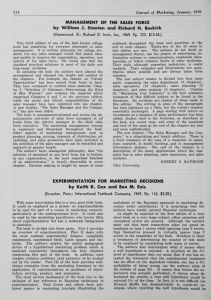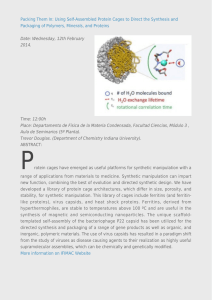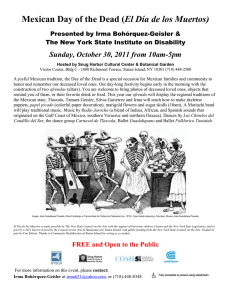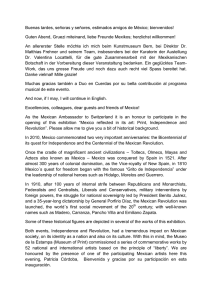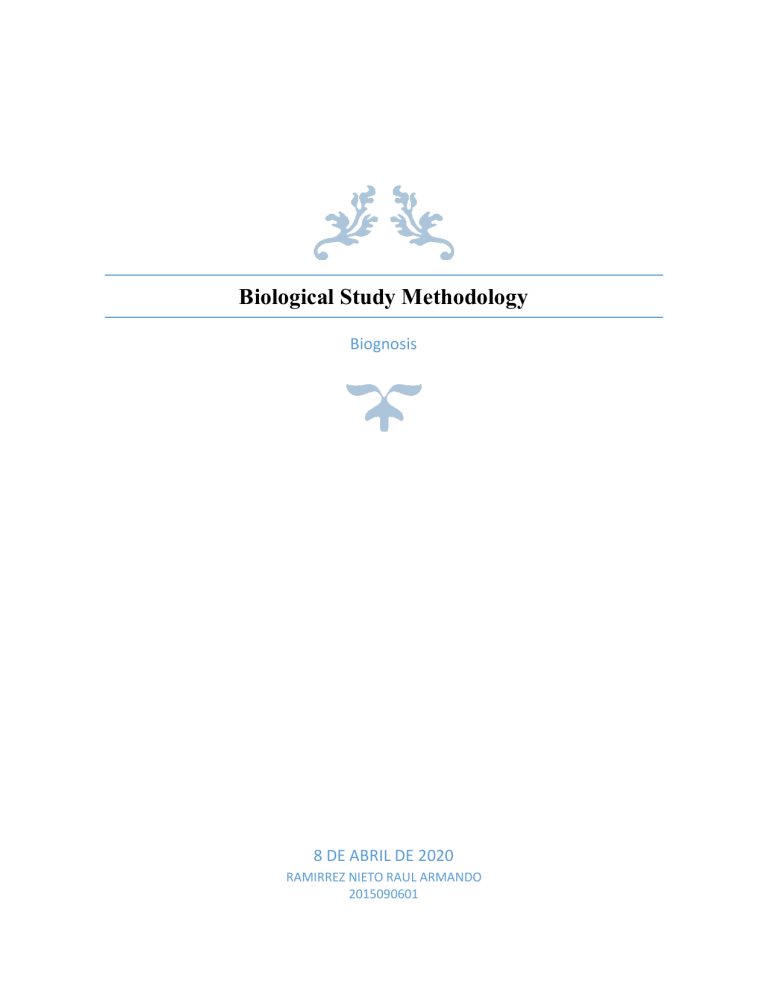
Biological Study Methodology Biognosis 8 DE ABRIL DE 2020 RAMIRREZ NIETO RAUL ARMANDO 2015090601 1 Content Mexican regulations for animal experimentation (NOM-062-ZOO-1999) ........................................ 3 1.1 History of Animal Experimentation: .................................................................................3 1.2 Animal Experimentation in Mexico: .................................................................................5 1.3 Important Points: ............................................................................................................6 1.4 Euthanasia:.................................................................................................................... 14 1.5 Bioethical Problems: ...................................................................................................... 14 Methodologies for planning experiments. .................................................................................... 16 2.1 Experimentation. .............................................................................................................. 16 2.2) Experimentation as a Process: ...................................................................................... 17 2.3) Control Problems in Experimentation and Validation. .................................................... 18 2.4) Definition of Variables. .................................................................................................. 18 2.5) Experimental Designs .................................................................................................... 19 Acquisition of Biologic Variables: Trajectories and position, study of morphologies, study of mechanisms and functions. .......................................................................................................... 21 3.1 Trajectories and position. .............................................................................................. 21 3.2 Study of Morphologies .................................................................................................. 21 3.3) Study of Mechanisms and Functions. ............................................................................. 22 BIBLIOGRAPHY: ............................................................................................................................ 23 2 Biological Study Methodology In the history of humanity, our species has always been dependent on other organisms, either for cattle, clothing, agriculture, transportation, hunting, etc. It's not surprising make the statement that without animals, society as we know, would be different or inexistent, just by the simple fact that in modern times we still use them for the same purposes as in the past because they're essential for the economy and growth of a country, but not limited only for these activities, animals nowadays they're used in the pharmaceutical, cosmetic and scientific industry, commonly as test subjects. In the last decade, we saw different organizations against animal cruelty more active than ever, taking a most assertive posture in terms of animal experimentation, even with the public declaring that they're uncomfortable buying products or affiliate with brands who use marsupials, rodents, chimpanzees, rabbits or another specimen known by its terrible and extensive use within their white-clean rooms, making them suffer in a meaningless way or putting an enormous amount of stress. So it is correct to assume that it is necessary the action of organizations like PETA ensures the rights for the tests animals, government action to apply laws of regulation, talks of animal cruelty awareness and educate the youngest ones about the key roles that play every animal on earth. In Mexico exists a normative that regulates these practices known as the: "Mexican regulations for animal experimentation (NOM-062-ZOO-1999)", putting valid cases in which cases it is correct the use of animals and what methods for experimentation are valid to obtain the best results with the lowest discarded assets in an ethical way, applied to every research facility, Institutes, and education centers, all of it regulated by this norm of the government. These experimentations can be used to obtain the reaction and the effects of a new drug, the behavior of subjects under certain circumstances of stress, habitat or environment, the study and behavior of a subject with a certain disease, to obtain mechanical variables of certain species in order to mimic it, enhance it or putting it in another mechanical system; test new cosmetic products that can be harmful to human skin, etc. Whoever, even with those facts, in this country exists a global concern about its natural habitats and how they are being reduced drastically due to corruption and private interest, and it´s a global concern because this country it`s one of the seventeen megadiverse countries, housing a 10% of the world registered wildlife, most of them endemics. Within animal exploitation, exists a huge number of cases of animal cruelty of domestic animals and animals used for test cosmetic products by national and international entities taking advantage of loopholes within this Mexican normative. 3 Mexican regulations for animal experimentation (NOM-062-ZOO-1999) 1.1 History of Animal Experimentation: Old Ages: First of all, we need to get into the context of what it has been this practice before modern times, and surprisingly we can trace the animal experimentation back in the ancient Greek civilization. Where it first appears the one who's considered the first biologist experimenter named Acmeaon of Crotona, with Hippocrates teachings and his famous bisection who gave a pig tinted water to see the action of swallowing. Aristoteles (384-322 b.C.) wrote an encyclopedia in which describes all that he knows with citations of the basis of the validity of animal experimentation and others like, Herophil and Erastrastrates, whom back in the great city of Alexandria existed, they prof de difference between tendons, muscles, and the nerves. Even we can find Greek archives of early essays of toxicology tested. Much of these practices were elevated and imposed among the educated and the church. Generations after generation treated these studies as definitive, such as the practices made from Galen (130 – 210 a.D. ), who it is known by doing dissections on various animal species among the public serving the function of education and, his studies about the function of the lungs, the heart's blood vessels and the nerves that came from the brain and spinal cord. The Middle Age: This era of history it's known by the step-back that humanity took, it can be justified by religion due to they saw wrong the dissection of any living or dead creature, and practicing it was considered heresy by the catholic church, just some places like the Salerenitan School of Medicine practiced scientific-based medicine in the centuries IX and XII, testing their knowledge inherited by Galen and practiced in the pig, "The most human-like creature". But in Asia things were different, in China, Chao-Fu was known as the first veterinarian with degree, using medicinal plants, acupuncture and some others external procedures, even veterinarians traveled from Korea and Japan to China in order to study horse acupuncture, even forming the first school for horse doctors, in Osaka, Japan. 4 The Buddhist and Hindu religions, their historic importance in this period, based on the philosophy of any living creature has the same value as others, as also every living creature are susceptible to the pain, not like Catholic Church and to some extent the Muslims, that their way of thinking very living creature except for humans, don't feel pain due to lack of consciousness The Renaissance: In the Renaissance, it was born a new wave of thinking named curiosity and like a disease, it spread to the educated, royal families, artists, and even the common people has it. Science and medicine saw a golden age within this two periods, trying to understand the different functions of organs and tissues, and they do so first with the use of corpses, a thing that would be penalized by the church before, but the researchers saw a problem, what will happen when there are no more corpses, so they started using animals once again even more if they wanted to study living tissue. English philosopher, Francis Bacon, declared that the use of animals is vital for science to move forward due to the high correlation of mammals in how the organs work. Meanwhile, William Harvey in his work: Exercitatio anatomica de Motu Cordis et Sanguis in animalibus, established a more proper way of how the circulation of blood occurs, thanks to the experiments conducted by him. The Illustration: In this period, all progress achieved in the renaissance was enhanced, but also the ethical problems of this methodology starts to spread, touching topics like the suffering of animals in the pursuit of knowledge. For Edmund O'Meara the practice of bisection generates suffer to all individuals involved in the experiment, generating an anti-naturalism state for both, the perpetrator and the victim of the experiment. This was new for the scientific community, making such a bold statement made some to rethink of what is correct, others justifying the use of them, even claiming that it is an exaggeration for the activist group to suggest self-regulation. XIX & XX CENTURY: During this period, happened one of the most important things ever occurred in the history of medicine, in 1798 result from seizures of a cow infected with smallpox, a doctor is driven by its curiosity and fascination of how some of the rural people who work with these animals 5 were unharmed by this disease, his name was Edward Jenner and he created the vaccination, and in these centuries we saw the golden age of medicine with the creation of drugs and new methods of medical diagnostic, obviously tested in animals. In 1825, Charles Darwin, tried to promote the “Act of animal cruelty” in the British parliament, one of the first official laws that regulates the animal testing, but make no mistake, Darwin was okay with animal experimentation if, the purpose it’s the elaboration of scientific thesis and not just mere curiosity. At this point in history, thanks to the discovery of the anesthesia in the XX century, the number of experiments with animals grew up, thanks to the properties of anesthesia, that made the vivisection of the animal more ethical and painless. But also legislations to regulate the use of animals in experiments, due to lack of legal limits and the creation of terms like animal welfare and declaration of animal rights, to maintain a moderate and conscious use of this creatures XXI – Present Times: Nowadays the use of animals it’s been more controversial than ever, creation of laws in all around the globe in pro of animal rights, strict regulations even banning test and experimentation of cosmetic products on animals in places like the European Union, Canada, India, Norway, New Zealand, Israel and South Korea. Laws like the “Good Laboratory Practice” and “Animal Welfare” in the USA, Cruelty to animal Act in the UK, “Ethical Principles and Guidelines for Scientific Experiments on Animals” in Switzerland, promote the searching of new methodology for animal experimentation, there is the importance of the new breakthroughs in genetic engineering, biotechnology and in vitro experimentation. 1.2 Animal Experimentation in Mexico: In Mexico the use of animals has always been a controversial theme, due to traditions and us of them, so it is fair to say that experimentation is no strange in terms of controversy either. In Mexico exists an Animal Welfare legislation, that includes the Federal Animal Health Act and the General Wildlife Law, these laws protect and grant rights to all animal that are present in the Mexican territory, and by no means this excludes the laboratory animals. And thus the Official Mexican Norm NOM-062-ZOO-1999, containing the basis of animal care in experimentation, reproduction, how to acquire them, how to establish a proper use of them, how they need to be treated in the most humanitarian way, and how and when to use 6 euthanasia. This norm requires that every institution counts, with capable personnel, certified laboratories and more important requirements like the participation of a medic veterinarian as the general manager. And also requires the participation of various several ministries, like The General Health Law in Health Research Matters, who is responsible of compliance in avoiding as much as possible the suffering of any animal in a laboratory, as equal in his death in every experiment or research, or the Ministry of Agriculture, Livestock, Rural Development, Fishing and Food who is responsible of the expedition of animal health measures in verify and certify the compliance of the animal health measures; and to guarantee of the production, health protection and good use of every animal in the laboratory. 1.3 Important Points: This normative is conceived by 15 points, and here, is the most relevant of the norm (This points appear in order and with the same number as in the original document): 1. Objectives and application fields. This point establishes that every laboratory in the Mexican Republic has to follow the Norm with the objective of establish and uniform specifications for production, care and use of the animals of laboratory for every physical and moral person with a relation with the following animals (Table 1.a). Table 1. All Bioteries who experiment with these animals are obliged to follow the Norm. Class Rodent: lagomorphs: Carnivores : Porcine: Primates: Animals rats, mice, guinea pigs, hamsters and gerbils. Rabbits Cats and Dogs. Non-Human Primates. The Ministry of Agriculture, Livestock, Rural Development, Fishing and Food and the General Directorate of Animal Health are responsible for compliance and observation of this norm. 2. References. This norm has to follow other norms related to animal rights and security protocols needed to the correct function of the laboratories, these norms can be englobed in the following scheme (Esquema 1): 7 Laboratory Animals: • NOM-003-ZOO-1994: Criteria for the operation of approved testing laboratories in animal health matters. • NOM-029-ZOO-1995: Characteristics and specifications for facilities and equipment for testing and / or analysis laboratories in animal health matters. • NOM-033-ZOO-1995:Humanitarian sacrifice of domestic and wild animals. • NOM-046-ZOO-1995:National Epidemiological Surveillance System. • NOM-051-ZOO-1995: Humanitarian treatment in the mobilization of animals. Laboratories: • NOM-087-ECOL-1995: Establishes the requirements for the separation, packaging, storage, collection, transport, treatment and final disposal of biological-infectious hazardous waste. • NOM-008-SCFI-1993: Mexican Official Standard General System of Measurement Units. • NOM-018-STPS-1993: Recquisition of characteristics like the services of showers, changing rooms and lockers in the workplace. • NOM-028-STPS-1994:Safety-Color code for the identification of fluids conducted in pipes. Figure 1. Objectie Clasification of the norms. 3. Definitions and Abbreviations. In this part of the norm, we appreciate the use of scientific terms that are important to minimize confusion between terms and guarantee the correct use of them. In this list of terms, one stands out the most in the entire standardization: Bioterio, that basically refers to all laboratories who kept animals for experimentation during one or more of the phase of their life (birth, development, reproduction and death). 8 4. General Dispositions. The institutions who work with animals need to have certified Bioterios, this guarantee a good quality of work and preservation of the laboratory animals, this means that all laboratories, requires a veterinarian with experience in medicine and animal science in laboratories. The bioterio not only need a veterinarian, it also needs an Intern Committee for the Care and use of Animals, to ensure the correct following of every protocol present in this Norm, Technical Staff, required to maintain a proper function to every aspect in the laboratory, meaning that they need certain experience and knowledge in fields like anatomy, physiology, chemistry, metrology, etc. Every Animal acquired needs a certificate of precedence where establishes microbiologic and genetic status, health conditions, as well as identification data like: a) b) c) d) e) f) g) h) Name, address and company name of the provider. File number that is granted by the notification of operation notice. Animal species to which the certificate refers. Race, strain. Total number of animals. Sex, indicating the quantity of each one. Date of birth, when known. Laboratory and / or cabinet tests, including the date of the last performance to determine the microbiological status when required. i) Name and signature of the Veterinary Zootechnician certified in laboratory animals that endorses the certificate. Not only that, also every institution where animals are used for experimentation, needs to ensure that their habitats are clean at every time, every animal needs a clean and balanced diet (the diet needs to be must be free of additives, drugs, hormones, antibiotics, pesticides and contaminants, not past the expiration date and stored in a clean ventilated room), programs that prevents diseases, as well continuous observation with the objective to find changes in the animal’s behavior. Also the animals need identifications, the identification and application places can be different in every species (Figure 2. ID on a rat), the identifications can be: ID Cards: assigned to every anima in their box or cage. Natural Marks: These are considered only if the characteristic can be traceable without confusion. Dyes or tincture: used as a temporal identification within 20 days. Perforations and Notches. Earrings: placed in the ears of the rats, mice and porcine, the material can be plastic or metal. 9 Tattoo: Can be placed in different parts of the body according the species. Collars. Subcutaneous Transmitters: the only method that can be used in all the species. Figure 2: Areas where it can be Placed an Identification form in a mouse. Red: Dye or Colorants; Blue: Dye or Colorants; Black: Tattoos and Earrings. 5. Animals covered by this Standard. This point of the norm covers the animals that are recognized for experimentation under this standard, how they need to be threated, diet, medical care, space required, in other word, satisfy physiological needs. o Rodents: in the case of rodents the equipment designed to host these animals, must be designed for the good caretaking of the animal, giving an adequate space to free movement and adoption of normal postures for the species, also this area needs to be resistant to continuous cleaning, the spaces assigned must be accordingly to the species and its weight. Every one of the species within the rodent class must be separated from others with different microbiologic conditions. Also the food and water of these animals must be accessible for them. 10 The cages with solid floor where the rodents are place need to contain a bed that guarantee the urine absorption, excrement and water wasted. Tthis class of animals must be placed in groups where the space is limited by the following specifications: Animal, Weight (g), Floor Area per Animal (cm2), Height from the floor to the roof of the cage (Table 2). Table 2. Minimum space for Rodents living in laboratories maintained in cages. o Lagomorphs: for this class of animals it’s only contemplated the Rabbit. As well as the rodents, the cages of these animals must be in good quality, this cages must provide the basic needs of the individual, also, it is required to have the sufficient width and height for the free and natural movements of the animal. Every new animal has to be in a period of quarantine, if an exemplar presents symptoms of sickness, must be diagnosed, treated and retrieved from the colony. The diet of a rabbit must cover the minimum of these nutritional requirements on the stages of growth, pregnancy and lactation (Table 3): Table 3. Minimum Requirements Of Alimentation Raw Protein Raw Lipids Raw Fiber Ashes No less than 16.0 % No less than 2.5% No less than 14.0 % Mo more than 8.0 % 11 At least but not less important the manipulation of the rabbit must be realized by qualified personnel, by supervision of the Medic Veterinarian responsible. o Carnivores: this class of animal only contemplates dogs and cats, within the norm, the hosting of these animals must be in cages, either individual or collective, this cages must have the following dimensions (Table 4), these individual cages must contain a place for drinking water, dinner plate and adequate conditions for cleaning and disinfection. Table 4. Minimum Space Recommended for Cats and Dogs. Animal Cats Dogs** Corporal Weight Area Of Height (cm) (kg) Floor/Animal (m2) <4 0.28 61 >4 0.37 61 <15 0.74 61 Hasta 30 1.11 61 >30 2.23 61 Like every other animal, mentioned before, they need to be in good shape, meaning they to be cleaned, vaccinated against rabies and have a balanced diet, all this accordingly to the age and physiological state of the animal, also, manipulation and restraint techniques that are carried out with dogs and cats must supervised by the responsible Veterinary Doctor. o Non-Human Primates: the care of these animals it’s more complicated due of tenacity and intelligence of these animals, also the measures to protect their psychological stability, have the same priority as those concerning their physical health. Each individual needs between 0.063 and 0.163 m3/kg of space in their cages, this cages need to be wide and tall provisioning an adequate space for free movement, normal postures and behavior adjustments, one of the important things is trying to mimic the habitat behavior of the subject was originally from, if not, this can affect in a terrible way the subject. For the animal management, the primate cages must be equipped with a compression system providing a better form to inject the animal. 12 6. Facilities. The installations must be designed for the necessities of the users, experimental subjects and personnel, with defined sectors: Animal Housing Sector, Experimentation Sector and Support Operations. These Facilities can be Indoors or Outdoors. a) Indoors Installations: All bioterios that are in interior enclosures, may be built in a segment, wing, level or physical space of the building or land of the institution. b) Outdoors Installations: Outdoors Bioterios can be pens, grasslands, etc. They are the common method for housing animals and are accepted by the norm, but these installations must cover: protection against extreme temperatures and other adverse weather conditions. These two types of installations must count with: - Location: These areas are destined to hosting animals and must be placed as an independent form from occupied from humans. - Animal Areas: Basic sectors that ensures the animal hosting, physical separation of species and experimentation (Scheme 3). - Specifications of sanitary finishes: These areas must be provided with sanitary finishes that primarily favor hygiene as a means of preventing or spreading a disease. 8. Experimental Techniques. 1) Analgesia and anesthesia This technique is used in case the animal suffers mores pain than the procedure like an injection, marking or perforation. The drug used in this practice it is total responsibility of the researcher, this drug can be freely chosen, with exception of muscle relaxants or any paralyzing drugs due to this two kinds of drugs are not Anesthetics. It is recommended the supply of tranquilizers, analgesics and anticholinergics before the anesthetic. 2) Administration of fluids and substances. The general administrations of fluids and substances must be done according to generally accepted clinic and scientific practices, where the animal is immobile (Table 5). 13 Table 5. Routes Of Administration Of Fluids And Substances ** NOTE: + Allowed - Not Allowed Figure 3.Scheme of Animal Areas; A) Reception Area; B)Rooms for the production and maintenance of animal; C) Room of Multiple Uses, c.e) Area exclusively Outdoors; D)Support Areas ; 14 1.4 Euthanasia: In this point describes us the applied procedures applied in scientific researches to kill in the most humanitarian way an animal, with the purpose of eliminate or minimize the amount of stress, pain, emotional disturbance and suffering during a procedure. These procedures must be applied accordingly to federal laws; the selection of the methods need to include certain compatibility with the purposes of the experimental protocol, also the she selection of the protocol is total responsibility of the researcher or/and the veterinarian. The selection criteria of the euthanasia methods need to be: Induce the unconsciousness of animals in a minimum time. Induce death without producing signs of panic. Have compatibility with the requirements and purpose of the study. Have a minimal environmental impact. And also the selection and application of the methods need to be applied accordingly to the highest ethical principles. Application of the technique: 1. Use Tranquilizer, analgesics or immobilizing drugs, when the capture or immobilization causes pain. 2. No other animals should be present unless groups that are going to be sacrificed at the same time. 3. In the euthanasia of cats and dogs, the treatment must be benevolent. 4. After the euthanasia, it´s necessary the confirmation of the animal’s death. The personnel who conducts his technique must be properly trained and had experience on the normal behavior of the species who is going to be euthanized and how this affects the management. Some of the recommended methods can be inhalable agents, non-inhalable agents or physical methods, the convenience of every one of these drugs it depends on the brevity between the moment it is applied and the moment when unconsciousness is inducing (Scheme 4). 1.5 Bioethical Problems: It is well known that Mexico has terrible levels of corruption, and if we’re talking about animal exploitation is the same, is known that Mexico host 10% of the registered wildlife of 15 the word, and also that Mexico is the third largest cosmetic manufacturer in the world, but this “achievement” is product of once again, corruption. Cosmetics companies from all around the globe test their products here, due to the lack of enforcement of the norm(NOM-064-ZOO-1999), or even taking advance of legal holes of the same. “In Mexico there is a disaster, in fact, they come from other countries to experiment here because there is no law , because there is no regulation that prevents animals from being used in the cosmetic industry, what could be more banal than killing or mistreating to an animal to make a ‘lipstick’?” –Ricardo Monreal, Senaor of Morena With these words, Mexico seeks to be the second country in America Latina banning any experimentation with animals for cosmetic practices. Under this normative (NOM-064-ZOO1999), government branches, federal laws and various animalistic parties back had their first approach to the ban on animal experimentation back in 2019, trying to follow the examples like the European Union, Canada, India, Norway, New Zealand, Israel and South Korea. Accordingly, to the European Comission, more than 15,000 ingredients have been tested, so it’s unnecessary more experiments with these animals. Inhalable Drugs: NonInhalable Drugs: Anesthethics. Micrrowave Irridation. •Anesthetic Eter. Carbon Dioxide. Nitrogen and Argon. Physical Methods: Derivatieves of Barbituric Acid. Cervical Dislocation. Decapitation. Electrocution. Inadmisible Methods: Chemical Methods: •Chloral hydrate. •Use of Nicotine. •Chloroform. Physycal Methods: •Head Concussion. •Animal Drowning. Figure 4. We got an example of valid Methods to induce Euthanasia, In blue are the valid and most commonly used Methods, in Orange are the methods than can be approved by a committee under supervision, Also we have the inadmissible methods, due to unnecessary amount of pain and stress. 16 Methodologies for planning experiments. 2.1 Experimentation. Experimentation is based on the analysis of casualty, and implies the manipulation of situations where subjects face, by definition, experimentation consists in a set of activities, executed under a certain action (Kepel,1991). There are 2 types of experimentation the classic keep everything constant except the variable of interest and the modern, consists in an experience planned in advance, meaning that is an active form to access information where certain variables are manipulated to examine its influence over other variables, it is important that the researcher is who establishes the levels of the low control variables, avoiding free flux. Some advantages of the experimentations are a higher probability to obtain a desired effect, also, the control and variation in it, can modify the conditions to study the same situations maintaining and removing the aspect under study. But, some of the biggest criticisms of the experimentations, is that the real world passes to a second plane because experimentation does not represent a real-world situation, due to the fact that some factors are fixed, other problem, is the difficulty of the experimental design. (A) (B) Advantages Critcicism Higher probability to obtain a desired effect. Difficulty of experimental design. Can modify the conditions. High time cost. Random assignation of subjects to different conditions of the experiment. the eexperiment is far from reality. A higher exposure of different conditionss. Figure 5. A) Advantages of the experimentation; B) General Critiscisms of exerimentation. 17 Experimentation has two focuses, generalization focus and focus in the theoretical explanation of the experiment trying to describe the effects that appear in a given situation, trying to make it as analogous as possible to the real situation. Experimentation for theoretical explanation allows us to know the reason for certain behaviors. It is necessary to have a theory that allows us to explain the phenomenon and, then, develop the appropriate experiment and contrast this theory. These two types of experimentation differ in the existence or not of a theoretical construction that is intended to be tested and that determines the design of the experiment. Another two types of experimentation are: Field Experimentation: These experiments occur in real scenarios and the nonmanipulative factors are discarded. Laboratory Experimentation: These experiments try to create an artificial situation adequately for the development of an experiment. 2.2) Experimentation as a Process: 1. The Experimentation begins with the foundation of the hipothesis. 2. Operationalize the hypotheses on a set of variables and select the appropriate experimental design. 3. Experiment Realization and Data Collection. 4. Statistical analysis of the data is based on the comparison of the mean values in the experiment. 5. Obtaining the conclusions of the study. Figure 6. Experimentation Process. ACTIVITIES CARRIED OUT SIMULTANEOUSL Y 18 2.3) Control Problems in Experimentation and Validation. The main concern in the experimentation development consists in the control of errors that can be present, in order to mitigate its effects. The control can be achieved by a correct design of the experiment, using statistic techniques that can provide a better control the additional effects, these techniques of control principally includes random assignation of individuals, rotation of treatments to avoid problems. The execute of controls in the whole process of the experiment contributes to its validity. The control is an indispensable requirement in order to achieve intern validity, for that reason it is more present in laboratory experiments than in field experiments. There are two types of validation: o Intern Validation: is a precision measurement of the experiment, so other explications in the experiment, except of the hypothesis gets discarded, this also means, that the effect in the dependent variable have been caused by the independent variables in the most part. o Externa Validity: alludes the fact that the results on the study can be generalized to a certain group In the validation process, if exists the interest of prove more intern validation, this implies to apply a stricter controls meaning spend more time in the laboratory at the same time implying an elevated confinement of the real world and a low external validation. Also is worth mentioning that a low internal validation means also a low external validation 2.4) Definition of Variables. A) Independent Variables: Those aspects controlled by the researcher on the development of the experiment on the ones who assume that are the causal agent, those are the independent variables. This control can be done by pure measurement, and the reason for that it´s because the variable cannot be manipulated or the manipulation was not contemplated. 19 The normal thing to do is use three independent variables, the reason is that is hard to explain a concept cannot be expressed in a sole effect by one independent variable, also is uncommon that experiments use only one variable. B) Dependent Variables. This variable is also known as the criteria variable, it is the variable that measures the variation of the principal concept of the experiment, the one that is affected by the treatments and other independent variables, also, it allows us deduct one process of the different status. In the experimentation process the most recommended approximation is using diverse dependent variables (the number of these dependent variables largely dependent on investigator risk aversion), that show us different result patterns as a result of the variations on the independent variables. C) Exogenous variables The Exogenous or external variables are those who tend to deviate the study objective. These variables can influence in the impact on the independent variable over the dependent variable, meaning that it can occur the observable changes in the dependent variable are not produced by an independent variable. There are also error variables, are unnoticed, are unknown and are not measured, however, they can cause changes in the dependent variable that, in the eyes of the researcher, 2.5) Experimental Designs To classify an experiment design, the first thing to ask is if all the conditions are random, if the answer is yes we face a pure experiment, on the contrary, the next question is if it exists multiple experiments, and again, if the answer is yes, we are talking about a quasiexperiment. A quasi-experiment, is the study where the variables cannot be controlled by the researcher and works with natural or intact responses, also this kind of experiment does not adjust to the minimal requirements of the pure experiment due to the impossibility of randomly assign the conditions of treatment and obtain all the possible alternatives. In the Table 6 are the main differences. 20 And thus for a pure Experiment, the most common designs use multiple groups or factorial designs. The notation for describe this methods is the observation o measurements of the dependable variables and are represented by Oi, and the treatments are presented like Xi. 𝑋1 𝑂1 𝑋2 𝑂1 Where 𝑋1,2 represents the treatments possible, and 𝑂1 is the observation of the dependent variable that the experiment is realized. In these kind of design is complicated to assume that the obtained data corresponds to reality due to lack of control. Another model can be multiple group design pretest-postest, which allow us know if the groups were initially similar in terms of the observed variable and know the increments of the same. This model is useful when there is no group control. 𝑂1 𝑋1 𝑂2 𝑂1 𝑋2 𝑂2 𝑂1 𝑋3 𝑂2 … 𝑂1 𝑋𝑛 𝑂2 In other hand the data analysis can be analyzed in two ways, one can be analyze the change on the dependent variable that is produced in every treatment: 𝑂1 − 𝑂2 Generating one sole punctuation for treatment. Table 6. Difference Between a Quasi-Experiment an Pure Experiment. Characteristics Sample Definition Yes Participants Random Selection Subject Random Assignation by groups Treatment Random Assignation by groups External Variable Control Internal Variable Control Measurement Level Experiments Strict Yes Yes Quasi-Experiments Must Accomplish Requirements Yes Restricted Yes No Yes Not necessary. High Necessary Quantitative Medium Necessary Quantitative 21 Acquisition of Biologic Variables: Trajectories and position, study of morphologies, study of mechanisms and functions. 3.1 Trajectories and position. When we are thinking about trajectories and position of biologic variables, it is necessary to identify our variable of interest it can be an angle, velocity, or displacement, as an example the position angles of the arm when it moves, but how it can be analyzed? One way to do it, is finding a similar system that behaves in a similar way to our biologic system, in the case of the “arm movement” we have an analog system known as the “double pendulum”. Figure 7. Double pendulum System and it is behavior of one mass of the system. Once the system is chosen, the analysis of the system should be easier if we trace the movement of one of the two points across time, and try to explain this behavior in a mathematical way, like an equation represented in a plane and also there are some apps like Tracker that allow us to see the angle behavior just using a video. 3.2 Study of Morphologies 22 The Morphology, a branch of biology that studies characteristics like anatomy, shape and appearance, as can been noticed, these characteristics are outwards characteristics of an organism, to do this, the most important thig is to identify the most prominent feature in the species of interests, also, morphology can be studied on a smaller scale (cell types). The ability to compare two organisms through morphology is a necessity for every researcher. Comparative Morphology has helped us because when we compare organisms, we learn more of them, and those with more similar morphology are the most closed related, and as a result from this, anatomical similarities and differences it makes possible stablish the classification of organisms. Also, a good example of the use of morphology can be seen in the paper “Morphological Feature Extraction for the Classification of Digital Images of Cancerous Tissues” by JeanPierre Thiran and Benoît Macq, where it presented a new method for recognition of cancerous tissues automatically, based on the shape and size of the observed cells. In this paper, in the experimentation every image was obtained by biopsy using tissues of the lungs and digestive tract, and to obtain these images the technical equipment used for the image acquisition were a high optical scope and a CCD B/W camera. Other experiments like lotus flower, in which they try to mimic the hydrophobic properties of the flower, and this property is generated due to leaves have nanostructures on their surfaces that are coated with hydrophobic wax crystals, and to do this morphology is the key aspect of this experiment. 3.3) Study of Mechanisms and Functions. A living creature have several mechanisms that allows its existence, but first what is a biological mechanism. A biological mechanism allow the correct function of certain organism within certain conditions and limits, these conditions can be external or internal. Some mechanisms can be the respiratory mechanism; this mechanism allow the gas exchange with the medium, but how does it work, we know the route that the air has to follow in the human body and how does it work in a cellular way. But thanks to science and technology we now have equipment that can provide more information in chemical mechanisms as seen in the Figure 8. 23 Electrocardiogram •Measures the electrical activity of the heartbeat. •This measurement can provide information on the frequence that can be signs of dissease. Flouroscopy •Shows a continous X-Ray image transmited to a monitor. •It can be used to view the gastrrointestinal tract, visualize blood vessels and Organs. Computed Tomography •Provides a differen form of imaging known as cross secional imaging. •It can detect different tissues in a "slice", this method is used for the search in coon cancer. Nuclear Magnetic Resonance •This method can Provide a ful 3D imaging •With this instrument a electromagnetic wave is produced across time in a rotationary way, allowing to se with detail tissues, metal concentrations, etc. Figure 8. BIBLIOGRAPHY: i. Ruiz de Maya, Salvador & López, Inés. (2013). Metodología del Diseño Experimental. ii. "Biology: Comparative Morphology: Studies of Structure and Function ." Scientific Thought: In Context . . Retrieved April 08, 2020 from Encyclopedia.com: https://www.encyclopedia.com/science/science-magazines/biologycomparative-morphology-studies-structure-and-function iii. Thiran, J. P., & Macq, B. (1996). Morphological feature extraction for the classification of digital images of cancerous tissues. IEEE Transactions on biomedical engineering, 43(10), 1011-1020. 24 iv. Prado, M., & Daniel, J. (2016). Perspectivas de la Experimentación Animal en Ciencias Biomédicas (1.a ed., Vol. 1). Recuperado de https://mascvuex.unex.es/ebooks/sites/mascvuex.unex.es.mascvuex.ebooks/files/files/fil e/PerspectivasExperimentacionAnimal_9788460846161.pdf v. Fluoroscopy. (2019, junio 14). Recuperado 8 de https://www.fda.gov/radiation-emitting-products/medical-x-rayimaging/fluoroscopy#description vi. What is Computed Tomography? (2017, diciembre 5). Recuperado 8 de abril de 2020, de https://www.fda.gov/radiation-emitting-products/medical-x-ray-imaging/what-computedtomography vii. Suárez, C. (2015). Maltrato animal en México: la otra cara de la crísis del respeto a la vida. Tercera Vía. Tercera Vía. Retrieved 5 April 2020, from http://terceravia.mx/2015/10/maltrato-animal-en-mexico-la-otra-cara-de-la-crisis-delrespeto-a-la-vida/. viii. Morales, P. (2019). México busca convertirse en el segundo país en América Latina en prohibir las pruebas cosméticas con animales. RT en Español. Retrieved 5 April 2020, from https://actualidad.rt.com/actualidad/314796-mexico-prohibir-experimentacion-animalcosmeticos. ix. Miguez, M., Largo, J., & Perez, M. (2016). Perspectivas de la experimentacion animal (1st ed., pp. 17-42). Universidad de Extremadura. x. Vilches, L., & Zurita, M. (2014). LA EXPERIMENTACIÓN ANIMAL [Ebook] (pp. 15-40). Retrieved 3 April 2020, from http://expani.pdf. xi. Garibay, M. (2020). Mexican Senate passes bill to outlaw cosmetic animal testing - Humane Society International. Humane Society International. Retrieved 4 April 2020, from https://www.hsi.org/news-media/mexican-senate-passes-bill-outlaw-cosmetic-animaltesting/. Gil, G., & Rodriguez, X. (2019). Bioterios en México: 20 años de caos y riesgos. CONNECTAS. Retrieved 7 April 2020, from https://www.connectas.org/especiales/bioterios-en-mexico/. xii. abril de 2020, de xiii. Romero Herrera, T. A., & Hernández-Navarro, M. D. Actividad antioxidante in vitro e in vivo del extracto acuoso de pérsimo (Diospyros kaki L.), maracuyá (Passiflora edulis var Sims) y flor de jamaica (Hibiscus sabdariffa L.). xiv. DIARIO OFICIAL. (2001). NORMA Oficial Mexicana NOM-062-ZOO-1999, Especificaciones técnicas para la producción, cuidado y uso de los animales de laboratorio. (Primera Seccion). Recuperado de https://www.gob.mx/cms/uploads/attachment/file/203498/NOM-062-ZOO1999_220801.pdf 25 xv. S. de Aluja, A. (s. f.). Animales de laboratorio y la Norma Oficial Mexicana (NOM-062ZOO-1999). Recuperado 8 de abril de 2020, de https://www.anmm.org.mx/bgmm/1864_2007/2002-138-3-295-298.pdf xvi. Marczyk, G., DeMatteo, D., & Festinger, D. (2005). Essentials of research design and methodology. John Wiley & Sons Inc. xvii. Coral Moncayo, H. E. (1998). Utilización de métodos experimentales y de simulación numérica para la microzonificación sísmica de áreas urbanizadas en Andorra. Universitat Politècnica de Catalunya. xviii. Blackburn, H., Keys, A., Simonson, E., Rautaharju, P., & Punsar, S. (1960). The electrocardiogram in population studies: a classification system. Circulation, 21(6), 11601175. xix. Paul T. Callaghan. (1993). Principles of nuclear magnetic resonance microscopy. Oxford University Press on Demand. Paul T. Callaghan. (1993). Principles of nuclear magnetic resonance microscopy. Oxford University Press on Demand. xx. Smyth, D. H. (1978). Alternatives to animal experiments. Scolar Press Ltd..
